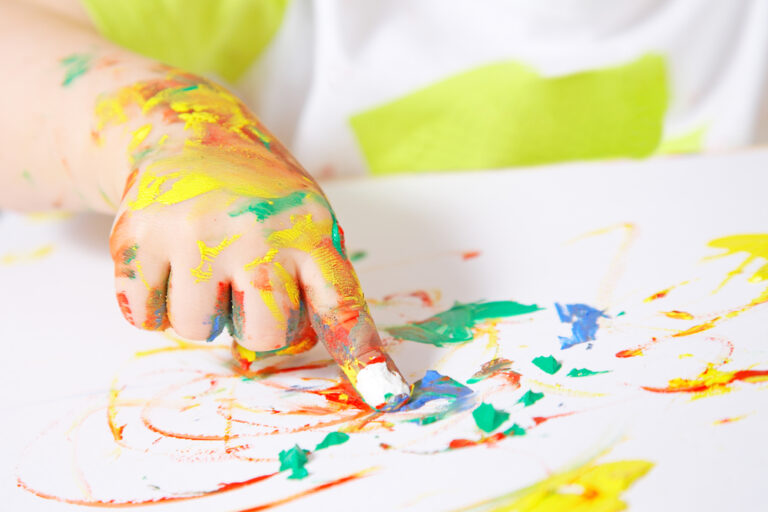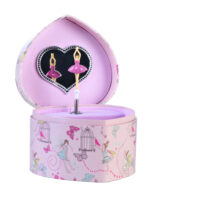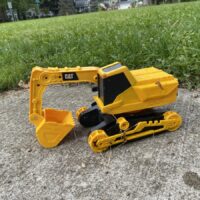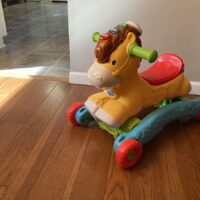Whether you’re teaching your one-year-old colors or letters or working with them on their motor skills, art projects for one-year-olds are a perfect portal to fun learning.
A child’s first five years are crucial to their wellbeing, health, and development. In fact, 85% of brain development happens by the time a person reaches five years old.
Art projects are one of the fun ways I helped my four children develop their brains and bodies as they grew from infant through toddlerhood and beyond.
6 Fun, Learning Art Projects for One-Year-Olds
Since toddlers learn best through play and hands-on activities, art is a true love of one-year-olds. Here are six fun art projects that you can do with your one-year-old and how to incorporate learning into them.
1. Finger Painting with Homemade, Edible Paint
My children always loved fingerpainting and still do! Finger painting teaches sensory skills, working with a slimy, smooth texture, and cold paint. You can also use it to teach colors. Besides this, finger painting helps one-year-olds develop their large and small motor skills.
Materials:
- Paper
- Edible Fingerpaint
- Fingers
Method:
I don’t need to explain the mechanics of finger painting. We, as parents, know how to do it. Your well-supervised and prepared (this, of course, means stripped to the diaper or dressed in an old t-shirt) toddler fingerpaints on a prepped surface. Whether you choose to do this outside on a toddler easel, which is what I suggest since it makes easy clean-up, or inside with butcher paper or old newspapers covering the floor, have your supplies ready before you set your toddler down.
What you may not have considered is that this of many art projects for one-year-olds may not require as much supervision as you think! You can make edible fingerpaint for your little tyke to practice his Picasso with, and his safety is guaranteed (as long as he’s not allergic, of course).
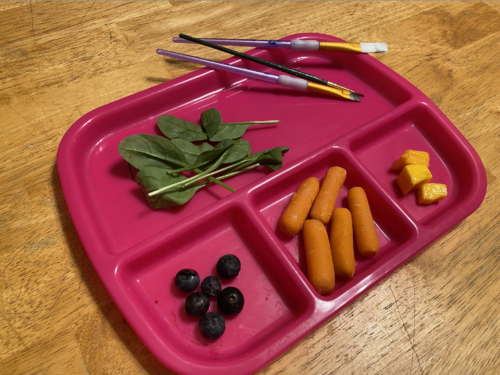
Making the Fingerpaints:
Following are the ingredients for making homemade, edible fingerpaints:
Yellow Fingerpaint
In a food processor, puree together:
- Six 1-Inch Cubes of Butternut Squash
- 1/2 cup of Dry Baby Cereal
- Water to Consistency
Green Fingerpaint
Puree together:
- 1 Cup of Spinach
- 1/2 cup of Dry Baby Cereal
- Water to Consistency
Pink Fingerpaint
Puree together:
- Three 1-Inch Cubes of Beets (Boiled until soft)
- 1/2 cup of Dry Baby Cereal
- Water to Consistency
Purple Fingerpaint:
In a food processor, puree together:
- 6 Blueberries
- 1/2 cup of Dry Baby Cereal
- Water to Consistency
Orange Fingerpaint:
Puree together:
- Three 1-Inch Chunks of Carrot (Boiled until soft)
- 1/2 cup of Dry Baby Cereal
- Water to Consistency
2. Feet Painting
This art project for one-year-olds will give your daughter a fun way to work on her walking skills! If she can walk by herself, you can ask her to stomp in specific colors or call out the colors she’s walking in. However, if she’s not, merely tell her which color she’s trekking through.
If your toddler is not yet walking independently, this is one of those art projects for one-year-olds that is best done with two adults. The reason for this is so that each can hold a hand so the paint can better be avoided by unwilling adult toes.
Materials:
- 1 Roll of Masking Tape
- 1 Roll of Brown Butcher Paper
- 1 pair of Scissors
- 2 Cookie Sheets
- 2 Colors of Washable, Non-Toxic Tempera Paint
Method:
Before beginning, use the butcher paper to cover a large amount of the floor. You can lay the paper side by side and make the rows wider if you want to (I suggest this if your little tyke is walking independently).
If you do this, overlap the pieces a little so that the paint doesn’t get through the cracks onto your floor.
Tape the butcher paper down with the masking tape. Masking tape holds well but should come up easily without leaving any residue.
Place enough tempera paint in the bottom of the cookie sheets to create enough for both feet to get well-painted when they come for a visit. Put a different color inside each cookie sheet. If you don’t want to use cookie sheets, you can use paper or styrofoam plates, but the plates tip easily. I’ve learned this from experience. Place each cookie sheet on opposite ends of the butcher paper.
Get your one-year-old ready for her art project by stripping her to her diaper or putting her in clothes that you don’t mind covered in paint. Going stripped can often be less stressful. The paint is washable and non-toxic, but sometimes, the idea of paint and clothing mixing causes parents a little stress… just a little.
Help her put her little feet in the paint. Tell her what color she’s stepping in. Hold onto her when she steps into it. It will be slick. Guide your one-year-old as she walks on the butcher paper to make her tracks.
Even if she can walk independently, she will need your guidance to stay on the paper so that she doesn’t run off and onto your floor. Although the bottle says the paint is washable, I’m sure you’ll want to avoid having to test the manufacturer’s claims.
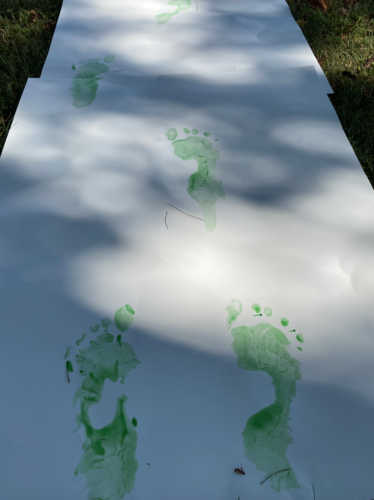
3. Van Gogh Foil Painting
Foil paint is one of those art projects for one-year-olds that will be both fun and educational. You can use it to teach the color blue and circle shapes. Your toddler will also work on developing his fine motor skills and have a chance to explore cause and effect as he sees colors change before his eyes.
Materials:
- Foil
- 1 Piece of Cardboard
- Tape
- Styrofoam Bowls
- Light Blue Tempera Paint
- Dark Blue Tempera Paint
- White Tempera Paint
- 1 Drop of Dish Soap
- Q-Tips/Cotton swabs
Method:
Place each color of paint in its own styrofoam bowl; it doesn’t take much paint in each bowl. Add 1 drop of dish soap to each. This will (in theory) help keep the paint from flaking and peeling off of the foil when it dries.
Cover the piece of cardboard with the foil. Fold the foil over the edges and tape it on the back of the cardboard.
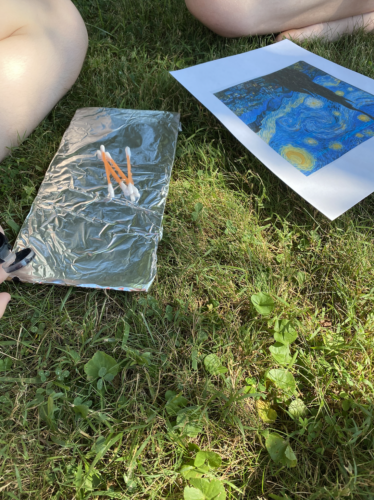
Show your one-year-old how to do his project by doing one yourself. Using a cotton swab like a paintbrush, paint different colored circles on the foil. Remind your toddler as he does this art project that he is painting circles and tell him what color he is using. Point out how the colors are changing as they mix. Let him have fun as he learns.
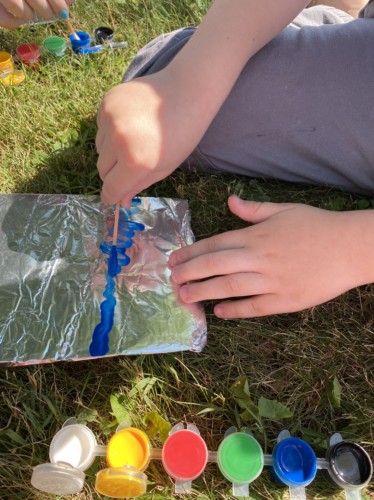
To add more learning to this already educational art project, you can pull out a picture of Van Gogh’s “The Starry Night” to appreciate together.
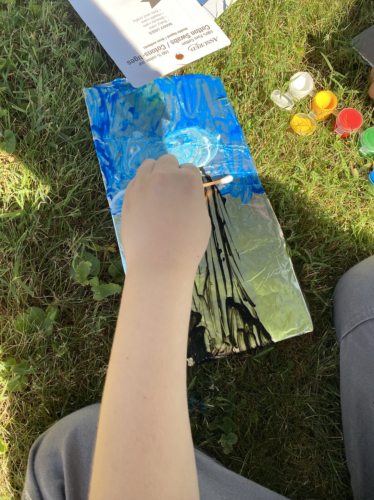
4. 1 Fish, 2 Fish, Red Fish, Blue Fish
This is one of the art projects for one-year-olds that was a favorite of my kiddos. But then they loved Dr. Seuss and still do. We read many Dr. Seuss books together again and again. This project can promote together time, as you can use it as an excuse to read this very book!
This art project will also teach your one-year-old colors, numbers, and large motor skills.
Materials:
- Black Permanent Marker
- Red Marker
- Blue Marker
- Red Tempera Paint
- Blue Tempera Paint
- White Construction Paper
- Scissors
- Paintbrush
- Baby Wipes
Method:
Using the white piece of construction paper, draw and cut out a fishbowl. Paint your one-year-old’s left hand red with a paintbrush. Place her hand horizontally on the paper (thumb-down and fingers in) and press it down evenly. Wipe her hand clean with the baby wipe.
Paint her right hand blue. Place on the paper (also thumb-down and fingers in) and press it down evenly. Wipe that hand clean.
After the paint dries, give both fish an eye and a mouth on the wrist side. Write “1 Fish” in black above the red fish on the left. Write “Red Fish” underneath it in red. Write “2 Fish” above the blue fish on the right and “Blue Fish” underneath it.
Write your daughter’s name and the date on the fishbowl and place it somewhere safe for a memory.
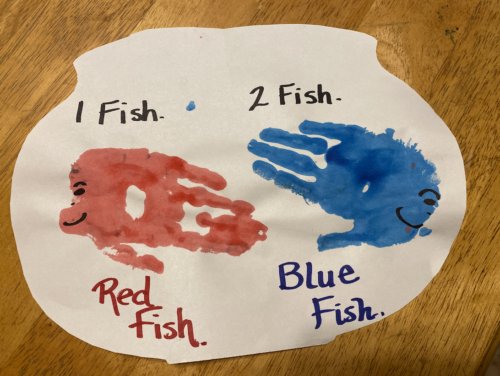
5. Rainbow of Cotton Balls
This art project for one-year-olds is pretty easy to figure out. Your toddler will learn colors, matching, and the word “rainbow.” He will also further develop his fine motor skills. You can also use this project to teach him texture, semicircle, and the word “dip.”
Materials:
- Blue Construction Paper
- Crayons
- Styrofoam Bowls
- Cotton Balls
- Tempera Paint
Method:
This first part is for you to do. You will need to use the proper color crayons and draw a simple rainbow and color it in. Make the rainbow long enough to cover the paper side to side and the rows tall enough for cotton balls to fit in. Only do five rows. If you need to do less, that’s fine. You don’t want the rainbow to look so full of rows that it no longer looks like a rainbow.
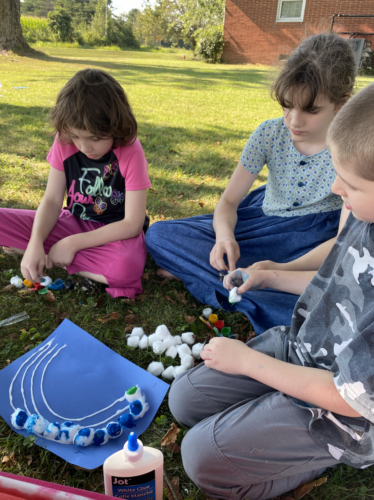
Cover the bottom of the styrofoam bowls with the tempera paint.
Teach your one-year-old how to roll the cotton balls one at a time in the paint. Guide him to placing each cotton ball on the color that it matches up to.
Once the rainbow is completely filled in, let it set to dry! The dry paint will effectively “glue” the cotton balls to the paper.
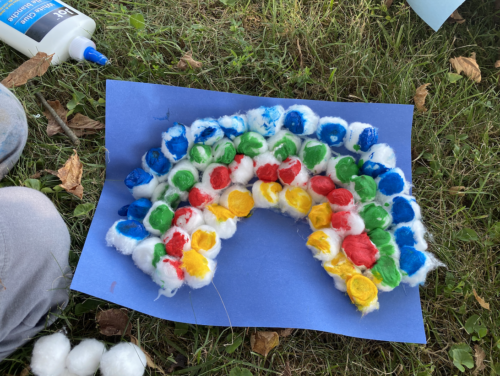
When I did this with my kiddos, since they’re a little older, I had them only dip one side of the cotton ball. We then glued the dry side to the paper. If you choose to do this, it may be less messy, but your toddler will need more help.
6. O is for Octopus
This is another one of those very educational art projects for one-year-olds. It can teach the color your choose, the letter “O,” the number “8,” and counting to 8. It also helps your toddler develop her fine motor skills.
Materials:
- 2 Pieces of Matching Construction Paper
- Scissors
- 8 Cheerios
- Non-Toxic Glue
- Wiggly Eyes
- Permanent Marker
Method:
My 20-month-old absolutely adored this art project when we did it years ago! All four kids loved it again as we did it today. First, you have some prep work to do, but you do it in front of your toddler and talk her through what you’re doing.
Cut the first piece of paper into an “O”. Explain to your toddler that this “O is for Octopus” and that “O says o, o, o.” Often, one-year-olds, especially the older variety, will try to mimic you. They are eager to learn.
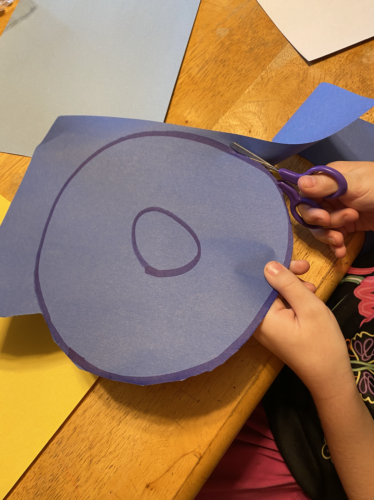
Next, cut eight strips, longways, from the other piece of paper. Let your one-year-old help you accordion fold the legs (let her squish to her heart’s content).
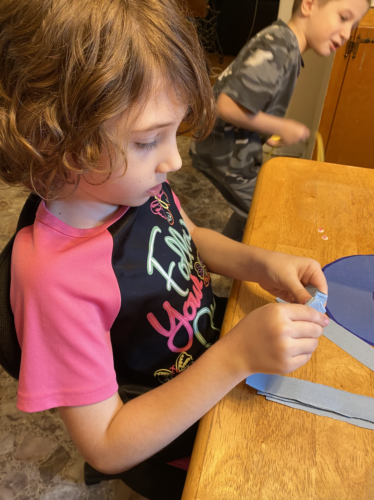
Put strips of glue on the bottom of the “O”, and let your toddler glue them on. These are the octopus’ eight legs. Count 1-8 with your one-year-old as she is gluing them on.
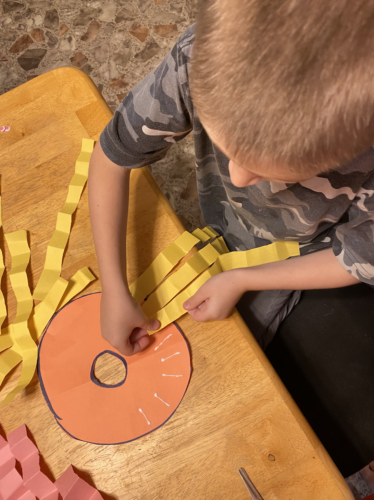
Put dots of glue on the bottoms of the legs (octopuses need feet, of course). Let her glue the cheerios there–one cheerio on each leg. Count 1-8 with her as she glues them on. Write the numbers 1-8 on the octopus’ ankles. Count 1-8 with your one-year-old as you write the numbers on her art project.
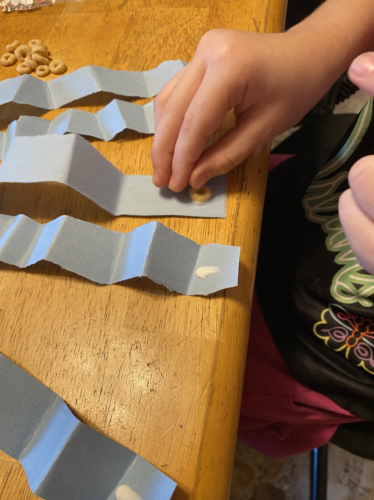
Put dots of glue on the top of the “O” and let her glue on the wiggly eyes. Remind her the “O is for Octopus” and that “O says o, o, o.”
My two youngest decided to get creative and give their octopuses several eyes, and my teenager gave hers a mustache. Enjoy the results!
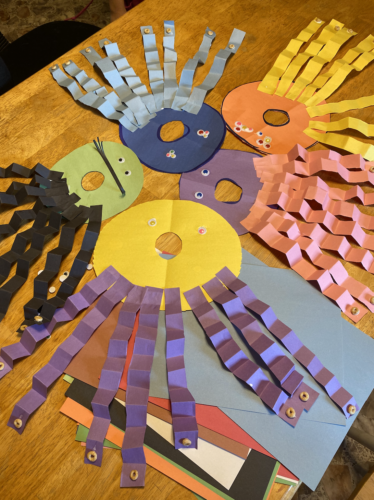
Have fun with your little tyke creating your own memories!
FAQs for Toddler Art Projects
What Does a One-Year-Old Need to Learn?
According to the Children’s Bureau, a one-year-old, typically, can understand what you are saying and respond. They can parrot your language, imitate what you do, and tell you who “Me” is and who “You” is. They can show you which things are the same and which are different and point to things and people that they recognize in a picture or book.
A toddler from one-to-two years old can typically move their entire arm to paint or color and scribble. They can usually sway and move their body to music, bend and pick things up off of the floor while they are standing up, walk backward, and walk up the stairs and back down again without help. A one-to-two-year-old can also turn door handles and knobs, which is always bound to lead to trouble!
What If My Toddler Hasn’t Reached These Milestones?
Raising Children reminds us that toddlers develop at different rates.
My first daughter was walking, potty trained, knew her letters, numbers through 10, some shapes, and her colors by 21 months. I started her in preschool (homeschooling) at two years old, and she was reading fluently by the time she was four. She still excels at everything she puts her mind to.
My second daughter didn’t potty train until she was three years old. She wasn’t ready for school until Kindergarten, and I’m not completely sure she was ready then.
My third daughter still struggles with basic math at nine-years-old, yet my seven-year-old (who doesn’t even start second grade for another few weeks) was doing third grade math last year! Every child develops at their own rate.
When Should I Be Concerned?
The CDC has a great breakdown of the milestones your child should have reached by certain ages and when to be concerned that they haven’t. According to the CDC, if your toddler hasn’t done the following by one-year-old, you should talk to their doctor:
- If he/she doesn’t point
- If he/she has not learned to wave
- If he/she doesn’t shake his/her head “no” or other such gestures
- If he/she is not yet saying single words (“dada”, “mama”)
- If he/she cannot crawl
- If he/she can’t stand when you or someone else supports him
- If he/she won’t look for objects that he watches you hide
- If he/she had any of these skills and lost them
If your toddler hasn’t done the following by 18-months-old, you should talk to his doctor:
- If he/she doesn’t point
- If he/she doesn’t recognize familiar objects
- If he/she doesn’t show other people things
- If he/she doesn’t seem to care at all that his caregiver has left or that she came back
- If he/she is not yet saying six words (at the least)
- If he/she does not learn new words
- If he/she doesn’t parrot or imitate other people
- If he/she cannot walk
- If he/she had any of these skills and lost them
Toddler Art Wrap Up
We have seen what a toddler should be doing by the time he reaches one-to-two years old. You can help him develop these skills in many ways. The above art projects for one-year-olds are one of these ways. Have fun with your little tyke helping him learn something new and helping him reinforce something old!
A one-year-old is constantly learning. Regardless of what you’re doing, you’re shaping his brain with everything you do.
Make your time with him fun with these art projects!
